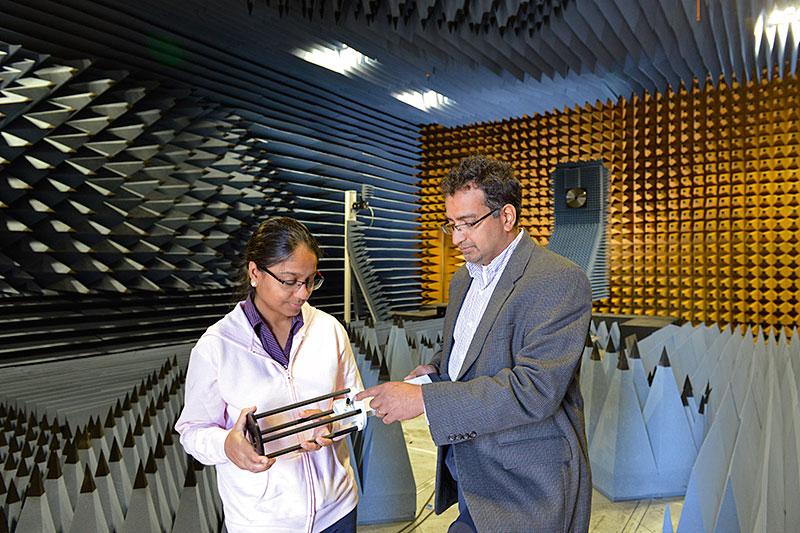Quiet zone—Patanjali Parimi (right), director of SUNY Oswego’s Advanced Wireless Research Center, and Neha Keshan, visiting research scholar from University of Calcutta, examine a wave guide that will help wireless signals zero in for testing to a receiver in Wilber Hall’s new world-class anechoic (echo-free) chamber, debuting to a variety of research partners following calibration and other tests.
A $3.1 million echo-free chamber will debut in SUNY Oswego’s Wilber Hall following calibration and other tests, formally crowning the college’s new capability for developing and testing wireless devices ranging from tiny blood pressure sensors to the antennas on a Humvee.
The anechoic chamber—at 45 by 32 by 16 feet, the size of a small gymnasium—is actually a building within a building, albeit one studded inside with thousands of blue and gold cones made of carbon-impregnated foam. It rides on a concrete foundation separated from the rest of Wilber Hall with a two-inch gap, one of many features that keep vibrations and electromagnetic and sound waves out in order to provide a pure environment for measuring wireless signals.
The chamber and the rest of the college’s Advanced Wireless Systems Research Center took wing thanks to a SUNY High Needs Grant and a collaborative SUNY 2020 grant on which SUNY Upstate Medical University, SUNY College of Environmental Science and Forestry and Onondaga Community College partnered. The research facilities are rich with promise for other partnerships of many kinds, said Pamela Caraccioli, deputy to Oswego President Deborah F. Stanley for external partnerships and economic development.
“SUNY Oswego’s talented research staff and students, extraordinary new anechoic chamber and the rest of our state-of-the-art wireless equipment provide fresh evidence that the college, along with the rest of New York state, is open for business,” Caraccioli said. “One of the key priorities of the SUNY 2020 grant is to stimulate entrepreneurial activity. Expressions of interest in our capabilities from as far away as China and as near as companies in our own region tell us we are on the right track in providing solutions in the rapidly growing field of wireless technology.”
Dr. Patanjali Parimi, director of the wireless research center, agreed. “Not only our challenge grant partners, but any company, university or other research partner can use this facility. We wanted this facility to be unique—a next-generation wireless facility. That’s the reason I coined the phrase, ‘from Buffalo to Albany, there’s no such facility.’”
Projects lined up
Wireless center staff members—including post-doctoral researcher Dr. David Senior and visiting scholars Neha Keshan and Prapti Ganguly from global-exchange partner University of Calcutta—are working on multiple projects: a sponsored grant to develop and test antennas with STI-CO Industries, a collaboration with Upstate Medical University to develop sensors for a smart system for monitoring stress and pulse rate in the human body, and another project on multi-phone wireless charging systems, Parimi said.
While defense contractors in the region have anechoic chambers, SUNY Oswego’s new lab is readily available to collaborators and built to standards that value potential partners. The wireless center—a companion lab is in SUNY Oswego’s Richard S. Shineman Center for Science, Engineering and Innovation—also provides academic opportunity aplenty.
“Our job is to carry on research and develop a unique curriculum in cooperation with other departments around campus,” Parimi said. “It’s going to take us a few years to get our name out. We need to publish papers in journals so researchers know this facility exists. In the next two to three years, I believe we’ll be able to acquire more and sustained research funding for the lab.”
He added, “We put a lot of thought into what type of research lab we needed to build. We challenged the manufacturer. We gave the manufacturer specifications for the design and we asked them to carry out research to meet them.”
Demanding specs
The facility, built by Cuming-Lehman Chambers, can produce a world-class quiet zone approaching -110 decibels. Researchers can conduct measurements of both near-field—very close to an antenna—and far-field signals within the laboratory. The chamber can operate in a relatively wide range of frequencies that covers most commercial and military-grade products, Parimi said.
Greg Ray, project manager for Cuming-Lehman, described the features of the chamber that keep electromagnetic waves—radio, mobile phone, satellite and others—out and the signals for testing focused on a targeted receiver inside. They include steel-sheet panels with copper wool sealing each joint, a reinforced floor, a precisely fitted and shielded door and ramp that can accommodate the aforementioned Humvee, and a distinctive pattern of foam cones and other shapes optimized to disperse sound within the chamber. Larry Gettino, coordinator of construction and installation for the college’s Facilities-Major Projects Office, added that the chamber is isolated electrically from everything else in Wilber Hall, and has separate heating, ventilation and air conditioning.
Mitch Fields, the college’s associate vice president for facilities, said the anechoic chamber posed a unique and rewarding challenge for his team. “To build something never built before to specs never achieved before—that’s fun,” he said.




